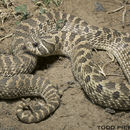en
names in breadcrumbs


When disturbed, H. nasicus will make mock strikes by jerking its body and flatten its head and neck. Its not known to bite but according to Tennant (2003), a man who was bitten on the finger, with the snake having chewed on for several minutes, experienced an anti-coagulant effect, followed by mild swelling and numbness that reached his elbow after several hours. No permanent damage occurred.
Western hognose snake
H. nasicus can reach a maximum size of about 90 cm, averaging between 38 to 64 cm. The dorsal pattern consists of sandy ground colored scales contrasted by more than 35 brown dorsal blotches from the snout to the vent in males and more than 40 in females. The flanks are speckled with brown scales and large spots. Like in other members of its genus, a prominent brown band crosses the eye to the forehead. The ventral scales are coal-black colored with white, yellow or pale orange edges. (Tennan, 2003).
H. nasicus has a more generalized diet than other members of its genus, which prey predominantly on toads. They will consume small mammals, amphibians, lizards and smaller snakes (Tennant, 2003).
Mostly active during the morning and evening, sheltering at night and during cold weather by burrowing into sandy soil, or, when on the surface, submerged in leaf litter (Tennant, 2003).
Short and mixed grass prairies in broken terrain where canyons provide seasonal water, gravelly or sandy soil which allows burrowing, and leaf litter litter or ground cover which provide shelter (Tennant, 2003).
Oviparous